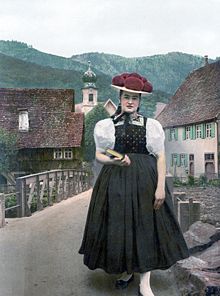Tracht


Tracht is a traditional national costume in German-speaking countries. Although the word is most often associated with Austrian and Bavarian costumes, many other peoples of Germany have them.
History
The Tracht of southern Germans and Austria has inspired an entirely new fashion style, called Landhausmode (Country Estate Style). Landhausmode, influenced by the costumes of the farmers, peasants and rural people, and characterized by the use of linen, loden (a traditional type of felt that has recently[when?] gained popularity worldwide) and embroidery.
In northern Germany some of the best known examples are the "Friesische Tracht" and the Finkenwerder Tracht. The "Friesische Tracht" is richly decorated with beads and embroidery. The quality of the work was a sign of the riches and social status of the farmer's wife wearing it. In former times it was brought into a marriage by the bride as part of her dowry. This costume is occasionally still worn at weddings. The "Finkenwerder Tracht" is the traditional costume of the inhabitants of an island in the Elbe river. It is worn by a local folklore group called Finkwarder Speeldeel. The long sleeved dark blue shirts with white stripes of the male costume are popular in Northern Germany for casual wear.
Visitors to the Black Forest region will be familiar with the wide brim hats decorated with big red pom poms (known as Bollenhüte) that are part of a Baden-Württemberg Tracht.
Displaced German peoples like the Sudetendeutsche often used events where they wore Tracht to emphasize their unity.
Costumes worn by professional guilds are also called "Tracht". While many have fallen into disuse, carpenter journeymen can still be seen wearing their traditional costume while traveling throughout Europe.
Other uses
Originally, the word "Tracht" had a much wider meaning in German in the sense of "what is carried/worn/borne", as it is connected to the verb "tragen", meaning "to carry/wear/bear". So "Tracht" can refer to the clothes which are worn, but e.g. also simply to a load, which is carried (until today within beekeepers' business referring to the load of honey carried in by the bees) or within the German idiom "eine Tracht Prügel" (a load (of) beating) to "a good beating".
-
Frisian Tracht from the North Sea isle of Föhr
-
Tracht from South Tyrol
-
Carpenter in Zimmermannstracht on the right
-
Danube Swabian women's tracht, from the historic house of the parents of Stefan Jäger, Hatzfeld, (Jimbolia), Romanian Banat
See also
External resources
- La Couturière Parisienne: Ethnic Costume
- List of Austrian trachts, in German
- Austrian Tracht and Folklore Group, in German
- Pictures of Tracht (with navigation via map or via list)
- "Treu dem guten alten brauch" founded in New York City in 1928 and still going strong!
Further reading
- Franz C. Lipp: Oberösterreichische Trachten, volumes 1 - 5.
- Hilde Seidl: Niederösterreichische Trachten. One of the most comprehensive works about Lower Austrian costumes.
- Christl Schäfer, Hannelore Rosenberger: Trachten aus und rund um Wien. Ein Werkbuch (mit Schnittmusterbogen). Leopold Stocker publishing house. ISBN 3-7020-0500-5




